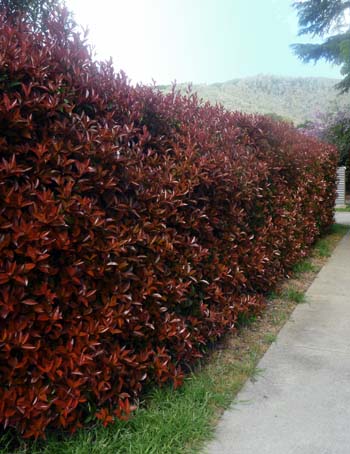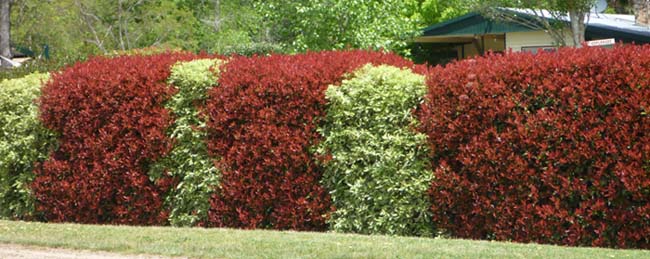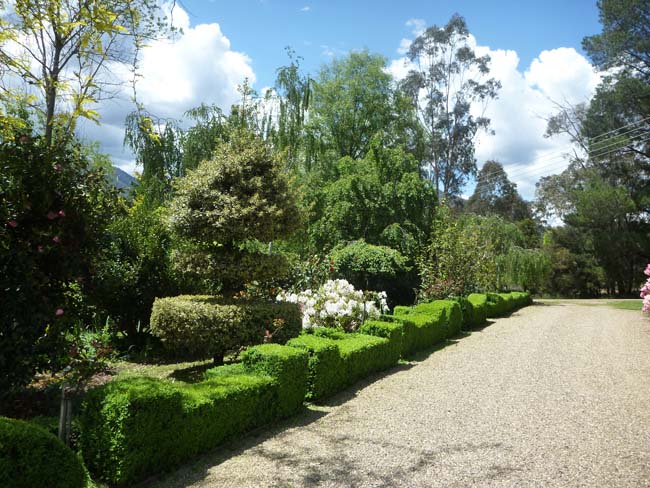
'Red Robin' is one of the most reliable
hedge plants for most Australian towns and cities
Late winter is a good time to consider new hedge plantings, as they will establish particularly well if planted at the beginning of the warmer months. As well as providing privacy a thoughtful choice of species for your hedge can also provide added ornamental interest through the texture and colour of its foliage or through flowers and fruits. For an informal hedge native plants such as grevilleas come in a stunning array of foliage types. Lillypilly or photinia can be used to create a formal hedge that gives a burst of bright foliage colour whenever new growth is produced. Recently introduced smaller varieties of Camellia sasanqua such as 'Little Liane' are perfect for a flowering hedge
Establishment and maintenance
of hedges
The months leading up to and including spring are an excellent time for planting hedges (allowing of course for the passing of frost danger). Hedges are worth considering for a number of reasons. They can provide a visual barrier around a property; a dense hedge can muffle traffic noise from a busy street or provide a break from a strong prevailing wind. A spiky hedge will also provide a physical deterrent to unwanted guests and that pesky neighbourhood dog that likes to dig up people's yards. Hedges can be used in artistic ways to partition your garden to create 'rooms' and intimate spaces.
Hedge styles
The classical image of a hedge is a neatly clipped, box-shaped living fence. Just as effective, however, is a less formal planting that is allowed to develop without intensive shaping. It does not necessarily even have to follow a straight line, as a meandering hedge can look fantastic if it is in keeping with a less formal garden design. An informal hedge also has the advantage that it can be allowed to flower and in some cases produce ornamental berries as well.

Mixed hedge planting of Photinia 'Red Robin' and variegated Pittosporum
Eugenioides makes a stunning picture when the new growth occurs in spring
Plant selection for hedges
There are certain critical features that a hedge plant must have to give the best result. Most importantly, the plant used must be extremely hardy and long-lived so that gaps do not develop in the hedge over the long term. Factors such as soil type and climate must be carefully considered and advice from your local garden centre or gardening friends will be very helpful.
If you are planning a formal hedge that will be clipped often to maintain a particular shape then a plant with relatively small leaves such as box (various Buxus species) is best as these can be clipped as often as required without looking ragged. Larger leaved plants such as Photinia are better suited to a less formal look, although they will respond to regular clipping if necessary.
For more information see our article entitled "Top plants for hedges and screens".

The small leaves of English Box (Buxus sempervirens)
make it the perfect choice for a formal hedge that will be regularly clipped
Establishment of hedges
Spacing is a critical issue in achieving a solid visual barrier. Exact spacings will depend on the species you are planting, but generally it is better to plant closer than normal to get the plants to mesh tightly together. Smaller growing plants such as box will need to be planted at closer centres such as half a metre, while a metre or more is ideal for larger growing shrubs such as camellias.
Water the plants very well the day before planting and use a string line to lay the plants out. Follow all the normal rules for planting trees and shrubs. A handy trick in windy areas is to provide extra support for the plants by putting in posts at either end of the hedge and attaching support wires between them. The plants can be loosely tied to the wires to prevent them rubbing excessively and damaging the bark.
Pruning of hedges
Shaping your hedge should start as soon as it is planted. The more you can encourage the plants to branch out from the base the better result you will achieve. One of the keys lies in tip pruning the plants constantly in the first couple of years. Simply pinch out the growing tips of the plant with your finger and thumb every few weeks while the plant is actively growing. Allow each shoot to grow at least ten cm before it is tip pruned again. This process will greatly increase the number of basal branches and create a dense, bushy effect.
In the longer term the amount of pruning required would depend on how formal an effect is desired. For a really solid, geometric style it may be necessary to trim several times from spring to autumn. To keep the top level use a string line just above the hedge as a guide. Informal hedges are best pruned straight after the flowers or fruits (if they are ornamental) have ceased to look attractive. Shears or electric hedge trimmers are the ideal tools if you can afford them.
Renovating hedges
Overgrown hedges are a challenge that requires careful management if you are to avoid creating an unsightly effect or ruin the plants entirely, particularly in the case of conifers that detest heavy pruning. A staged renovation over two growing seasons will guarantee the best result. In the spring, prune side growth back almost to the main stem on one side only and repeat the process on the other side the following spring (you may even be able to do it in late summer if you feel there has been sufficient regrowth on the side already pruned). To encourage vigorous regrowth, feed and mulch the plants at the same time as you prune. Well-rotted manure or slow release fertilisers are the ideal products to use, as they will encourage growth right through the warmer months.
About the author
Angus Stewart is the author of several horticutural books including "Creating an Australian Garden". Angus also appears regularly on Australian television and radio shows. Angus's website is called "Gardening with Angus".
